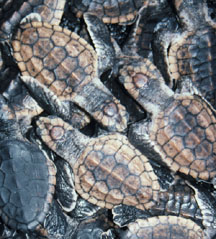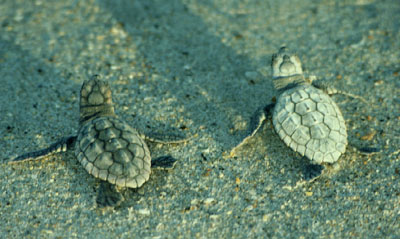

A hatchling loggerhead turtle emerges from its egg shell.
More than 100 hatchlings may emerge from a single nest.
Orientation and Navigation of Hatchling Loggerhead Sea Turtles
At the beginning of their astonishing journey across the Atlantic, baby loggerhead sea turtles from eastern Florida, U.S.A., emerge from underground nests, scramble to the sea, and immediately begin migrating toward the open ocean. The hatchlings first swim from their natal beaches to the Gulf Stream, a vast, warm-water current that sweeps north along the Florida coast. On the way, turtles appear to use three different sets of orientation cues sequentially. Follow the offshore migration links to learn how hatchlings use visual cues, wave direction, and the Earth's magnetic field to stay on course and guide themselves during their first few days in the ocean.
|
|
|
|
A hatchling loggerhead turtle emerges from its egg shell. |
More than 100 hatchlings may emerge from a single nest. |
The relatively short offshore migration to the Gulf Stream is just the first step in a much longer transoceanic journey. The Gulf Stream is one part of the North Atlantic gyre, the circular current system that surrounds the Sargasso Sea. After entering the Gulf Stream, young loggerheads remain in the gyre for a period of years as they grow and mature. During this time most cross to the eastern side of the Atlantic before returning to the North American coast as juveniles.
For young turtles in the open ocean, remaining within the gyre is critical for survival. Turtles that stray north of the gyre soon die from the cold, whereas those that venture too far south may be swept into the south Atlantic and carried far from their normal range. Follow the open-sea navigation links to learn about how young turtles exploit regional magnetic fields as navigational markers to help them stay on course and advance along the migratory route.
